Exercises (2276)
Extension and flexion of the arms while standing ► triceps press down / pushdown / pulldown
Power
Individual work
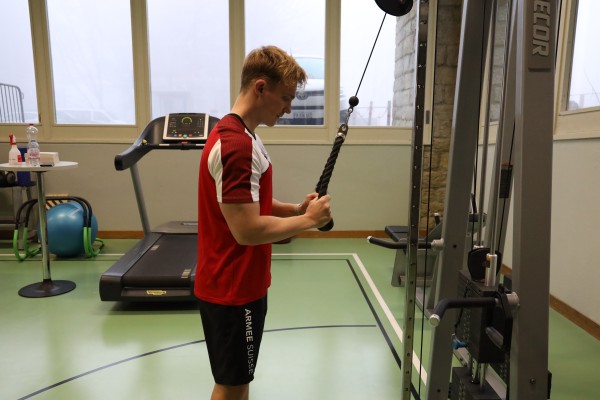
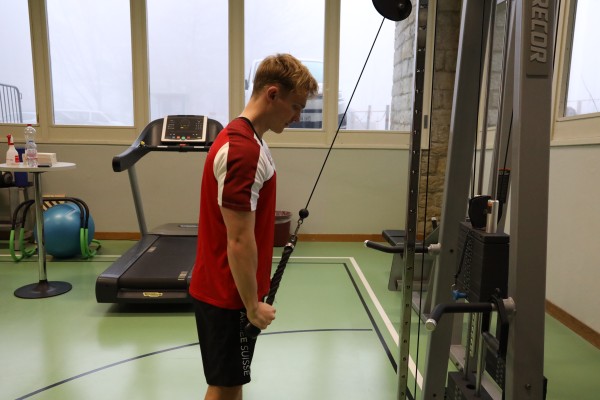
The cable pulley exercise can be performed with either the bar or the short rope, the cable pulley is attached at the top. Stand with your hips wide apart and your upper body leaning slightly forwards or in the basic position with your head upright and looking forwards. Grasp the bar or rope with bent arms, move the forearms downwards until the arms are almost fully extended. Then bring your forearms back up to the starting position. When performing the exercise, always keep your elbows close to your body.
Attention:
The movement takes place in the forearms. The lower back is in a slight hollow back position to protect the back.
Lighten:
Less weight.
Harden:
More weight.
Variant I:
Perform the exercise with one arm.
Variant II:
Change your grip technique: hold the bar with an underhand grip or use a parallel/rowing grip (V-grip).
1 weight tower/machine ► cable pulley (high)
Alternating extension and flexion of the arms while standing (rowing pull) ► row
Power
Individual work
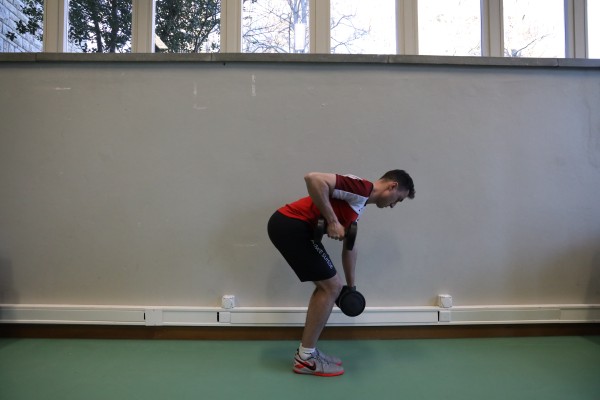


Standing shoulder-width apart, the upper body is tilted significantly forwards with a straight back, the weights (kettlebells or dumbbells) are held in the hands slightly below knee height with hanging arms (same side of the body), the weights are gripped with an overhand grip so that the backs of the hands are facing forwards. Raise the shoulder of the playing arm with the arm straight before bending the arm to bring the weight to the chest (elbow close to the body pointing backwards). During the movement, the arm is rotated outwards (back of the hand points to the corresponding side away from the body). Then, in the reverse sequence of movements, stretch the arm back to the starting position (internal rotation) before starting the exercise with the other arm.
Attention:
Always make sure your back is straight (keep your core tensed). The angle of your back and thighs should remain the same throughout the exercise. Pull your elbows back and up (keep them close to your body). The first impulse when lifting the weights always comes from the shoulders.
Lighten:
More weight.
Harden:
Less weight.
2 kettlebells/dumbbells
Alternating extension and flexion of the arms while standing ► biceps curl
Power
Individual work
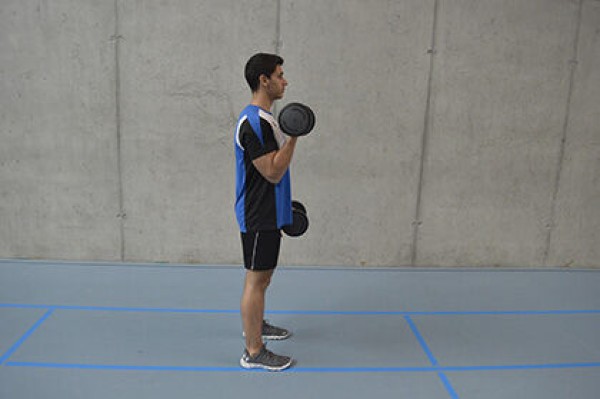
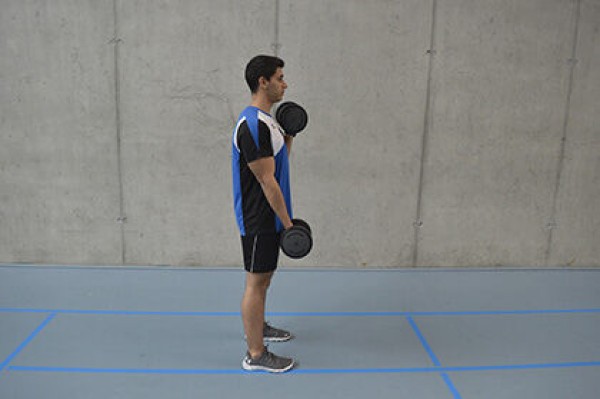
Stand upright, arms hanging with the dumbbells in your hands (underhand grip), the backs of your hands pointing backwards (towards your body), bend/bend your arms alternately (bring the dumbbells towards your chest, back of your hands pointing away from your body). The movement is performed using only the arm without supporting the upper body (leaning backwards). Lower the dumbbell back to the starting position by extending the arm before starting the exercise with the other arm.
Attention:
Keep your back straight, do not lean backwards (you may need to do the exercise with your back against a wall). back against a wall to maintain the position), keep your elbows slightly in front of your body, work without momentum.
Lighten:
Less weight.
Harden:
More weight.
Variant:
Bring your arms parallel to your chest (simultaneously).
2 dumbbells
Alternating extension and flexion of the arms while standing ► hammer curl
Power
Individual work

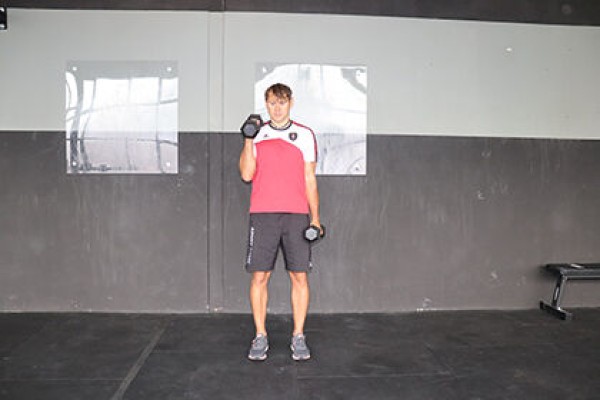

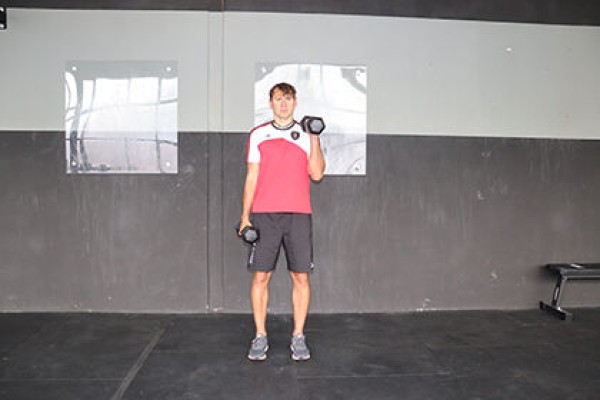
Stand upright, arms hanging with the dumbbells in your hands (neutral grip), the backs of your hands pointing to the respective side (away from your body), bend/bend your arms alternately (bring the dumbbell to your shoulder, back of your hands still pointing to the corresponding side). The movement is performed using only the arm without supporting the upper body (leaning backwards). Lower the dumbbell back to the starting position by extending the arm before starting the exercise with the other arm.
Attention:
Keep a straight back, do not lean backwards (if necessary, perform the exercise with your back against a wall to maintain the position), keep your elbows slightly in front of your body, work without momentum.
Lighten:
Less weight.
Harden:
More weight.
Variation:
Lift arms parallel to shoulders (simultaneously).
2 dumbbells
Extension and flexion of the arms in standing position with back position ► biceps curl
Power
Individual work
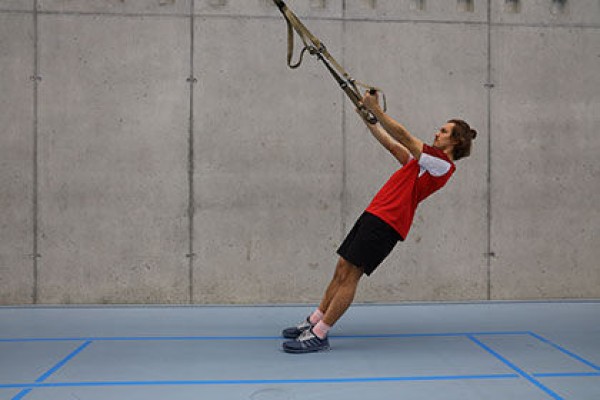
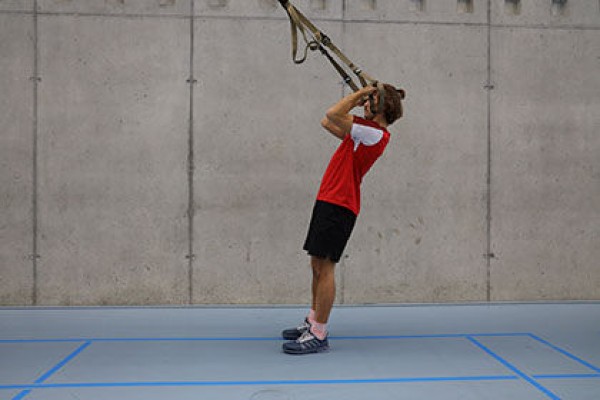


Set the sling trainer to a short length, stand upright and hold the handles with outstretched arms at shoulder height in front of your body, the slings are taut, take a step forwards (slightly backwards), pull your upper body towards the handles (bend and stretch your arms).
Attention:
Keep body tension, do not let hips sag, keep elbows in front of body.
Harden:
The more horizontal the starting position, the more challenging the exercise.
Variant:
The exercise can also be performed with just one arm (organisation = 2 exercises; train both sides).
1 sling trainer
Extension and flexion of the arms in standing position with template ► triceps extension
Power
Individual work
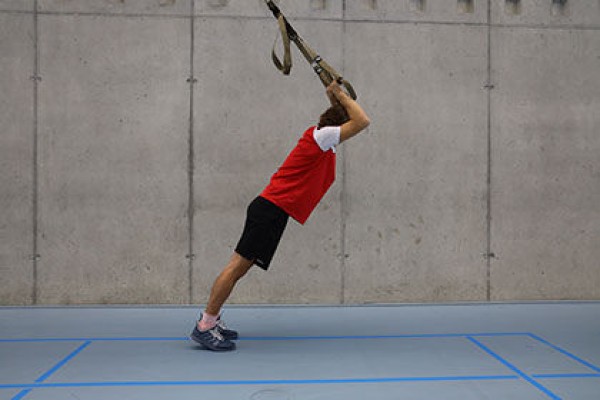



Set the sling trainer to a short length, stand upright (or in a walking position) with your back facing the attachment point, hold the handles (upper grip) and lean slightly forwards (handles are above your head with arms raised), stretch and bend your arms (raise and lower your upper body).
Attention:
The position of the elbows/upper arms remains stable (movement only from the elbow joint), maintain body tension, do not sag at the hips, no hollow back.
Harden:
The more horizontal the starting position, the more challenging the exercise.
Variant:
The exercise can also be performed with just one arm (organisation = 2 exercises, train both sides).
1 sling trainer
Extension and flexion of the arms in support ► tricep dip
Power
Individual work


Slowly lower your body while supporting yourself on the machine. The elbows point backwards and do not move to the side. Once the upper arms are parallel to the floor, push the body back up to the starting position.
Starting position:
- Body slightly tilted forwards in support
- Legs crossed
- Elbows point backwards and remain as close to the body as possible
Finishing position:
- Upper arms parallel to the floor
- Arms do not move out to the side
Attention:
Only go up to 90° at the elbows, elbows point backwards. The chest muscles are more active with a slight forward lean and the triceps are more active in a fully upright position.
Lighten:
Keep the support position.
Harden:
Tilt the upper body further forwards; additional weight on/between the feet.
1 power pump/machine support handles
2 weight cuffs/1 (medicine) ball ► make the exercise more difficult (additional weight)
Extension and flexion of the arms in support ► tricep dip
Power
Individual work
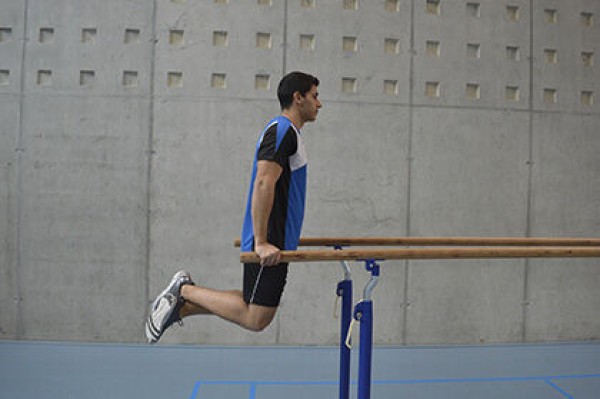

Support at the end of the bar, legs optionally bent and crossed, arms bent and stretched (upper body raised and lowered).
Attention:
Elbows remain close to the body and point backwards, slightly forward with the body, shoulders fixed (press towards the hips).
Lighten:
Support in place in the starting position; bend arms less; attach rubber band ends to both bars and place feet on band.
Harden:
Additional weight (on/between the legs).
1 bar
1 elasticated rubber band ► make the exercise easier
1 weight vest/(medicine) ball (e.g. foot, volleyball, basketball)/dumbbell ► make the exercise more difficult (additional weight)
Extension and flexion of the arms backwards in support ► tricep dip
Power
Individual work

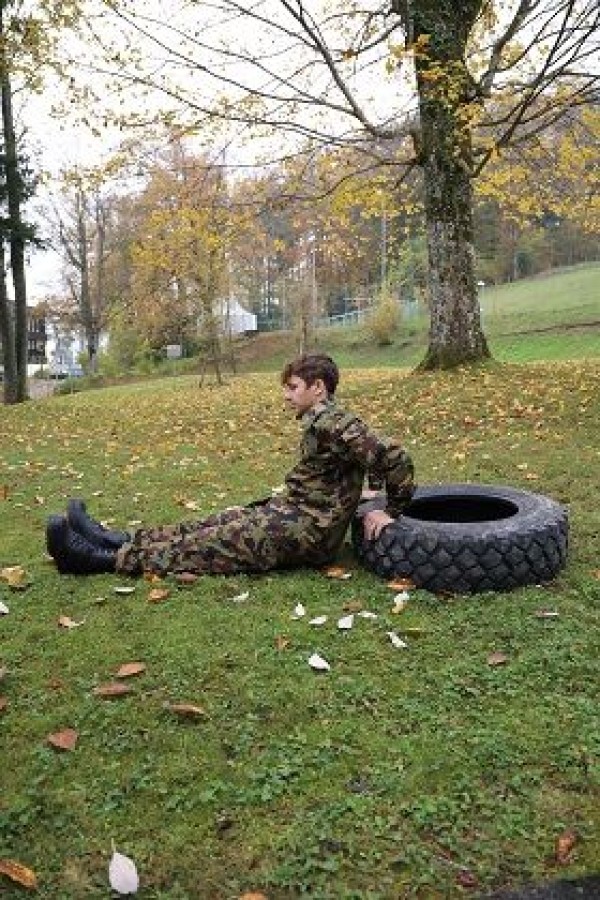


Four-foot stance backwards in front of the tyre, support your upper body with your hands on the tyre (arms behind your body), hands pointing towards your body, bend and stretch your arms (raise and lower your upper body).
Attention:
Elbows point backwards, keep your shoulders fixed (press towards your hips).
Lighten:
Foot closer to the tyre (legs more bent); bend arms less.
Harden:
Foot further away from the tyre (legs stretched and resting only on the heels); additional weight (on the thighs); unstable base for the legs.
1 tyre (10DM)
1 weight disc/sandbag/fighting backpack ► to make the exercise more difficult (additional weight)
1 ball/balance cushion/balance board ► to make the exercise more difficult (unstable base)
Extension and flexion of the arms backwards in support ► tricep dip
Power
Individual work
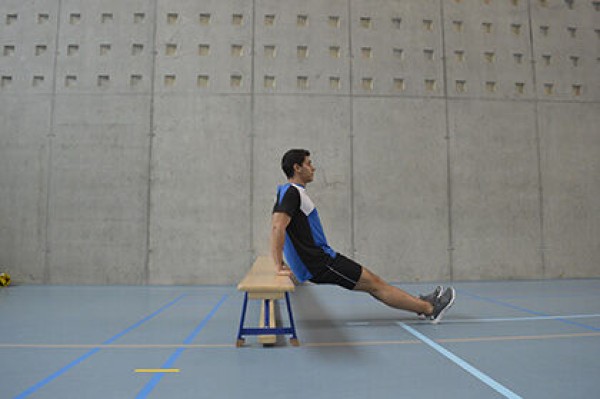
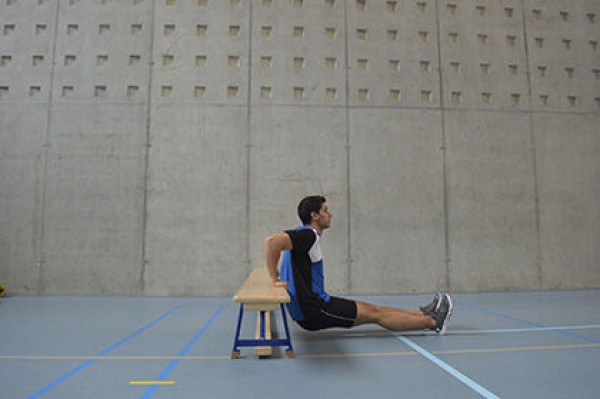
Heelstand with slightly bent legs, support your upper body on the long bench (arms behind your back, hands pointing towards your body), bend and stretch your arms (raise and lower your upper body).
Attention:
Elbows point back/stay close to your body, keep your shoulders fixed (press towards your hips).
Lighten:
Foot closer to the long bench/swinging box element (legs bent), arms less bent.
Harden:
Legs stretched; additional weight (on/between the thighs); unstable base for the legs.
1 long bench or 2 vaulting box elements (incl. top)
1 weight vest/weight disc/dumbbell/sandbag ► make the exercise more difficult (additional weight)
1 ball/balance cushion/balance board ► make the exercise more difficult (unstable base)
Extension and flexion of the arms backwards in support ► tricep dip
Power
Individual work
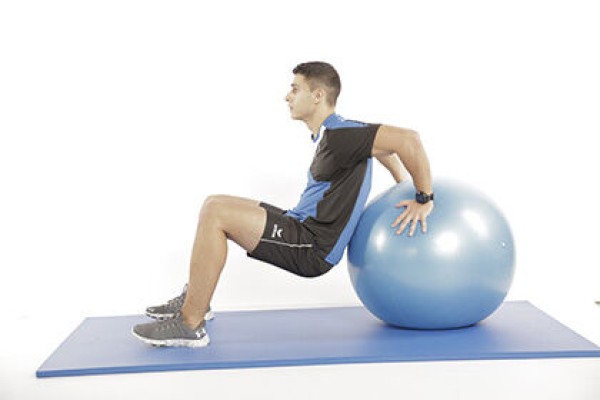
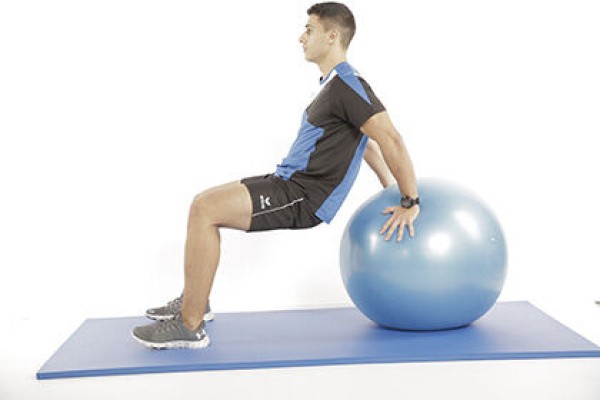
Heelstand with slightly bent legs, support your upper body on the exercise ball (arms behind your back, hands pointing towards your body), buttocks at knee height in front of the ball, bend and stretch your arms (raise and lower your upper body).
Attention:
Do not lower your buttocks (on the floor/ball), elbows point backwards, keep your shoulders fixed (press towards your hips).
Lighten:
Foot closer to the exercise ball (legs bent), arms less bent.
Harden:
Legs stretched; additional weight (on/between the thighs); unstable base for the legs.
1 exercise ball
1 weight vest/weight disc/dumbbell/sandbag ► to make the exercise more difficult (additional weight)
1 ball/balance cushion/balance board ► to make the exercise more difficult (unstable surface)
Extension and flexion of the arms backwards in support ► tricep dip
Power
Individual work
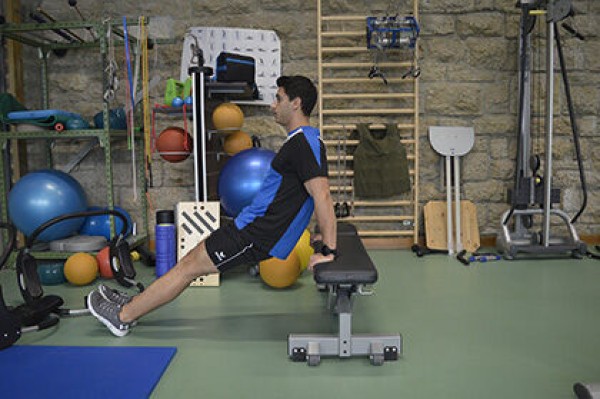
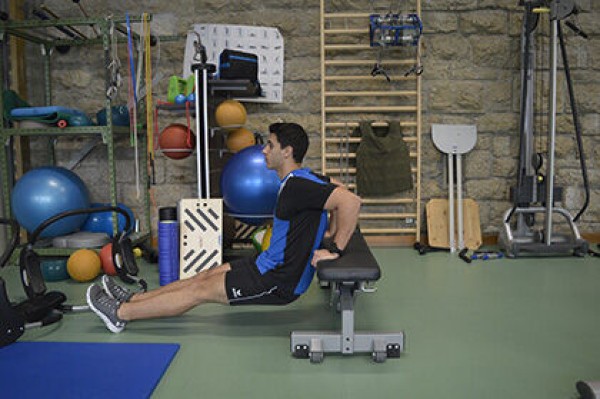
While standing on your heels with your back to the flat bench, rest the hands of your practically outstretched arms on the edge of the bench (fingers pointing towards your body). Bend your arms to bring your buttocks down just past the flat bench. Then straighten your arms to return to the starting position.
Starting position:
- Heel stand, body supported on the flat bench with arms almost straight
- Elbows close to the body
Finishing position:
- Elbows bent at approximately a right angle and pointing backwards
- Buttocks just barely not touching the floor
Attention:
The elbows are pressed close to the body and pointing backwards throughout the movement.
Lighten:
Foot closer to the flat bench (legs bent); bend arms less.
Harden:
Additional weight (on the thighs); unstable support for the legs.
1 flat bench
1 weight disc ► to make the exercise more difficult (additional weight)
1 ball/balance cushion/balance board ► to make the exercise more difficult (unstable surface)
Extension and flexion of the arms backwards in support ► tricep dip
Power
Individual work
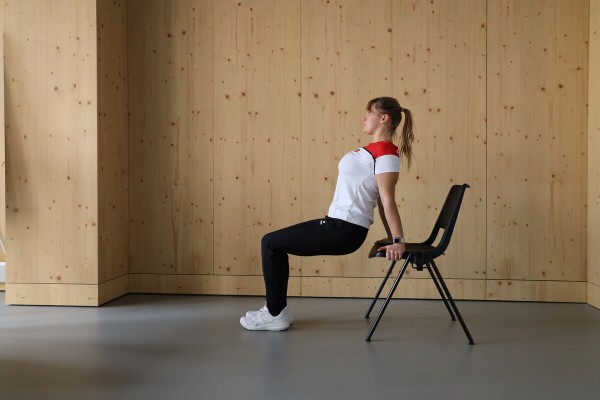
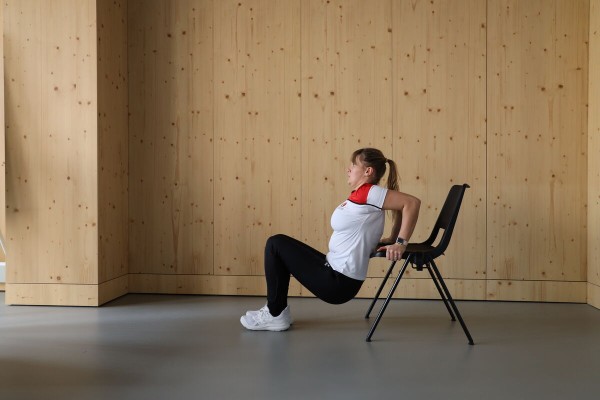
Place your legs on the floor with your knees bent at an angle of approximately 90 degrees and support your upper body with your hands on the seat of the chair (arms stretched behind your back, hands pointing towards your body). From this position, bend your arms and stretch them back to the starting position (raise and lower your upper body).
Attention:
Elbows point back/stay close to the body, keep your shoulders fixed (press towards your hips).
1 (office) chair
Extension and flexion of the arms backwards in support ► tricep dip
Power
Individual work

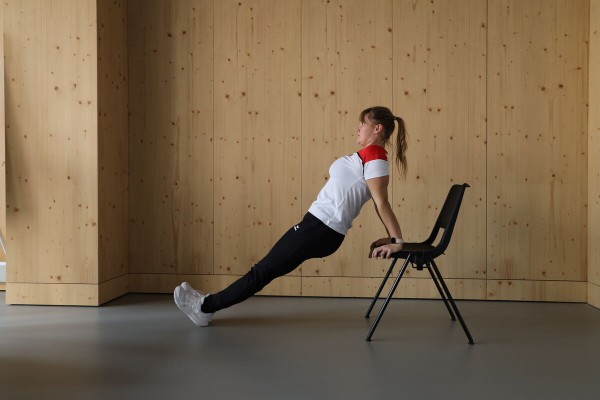
Stand on your heels with your legs stretched out, supporting your upper body with your hands on the seat of the chair (arms stretched out behind your back, hands pointing towards your body). From this position, bend your arms and stretch back to the starting position (raise and lower your upper body).
Attention:
Elbows point back/stay close to your body, keep your shoulders fixed (press towards your hips).
1 (office) chair
Extension and flexion of the arms backwards in support ► tricep dip
Power
Individual work
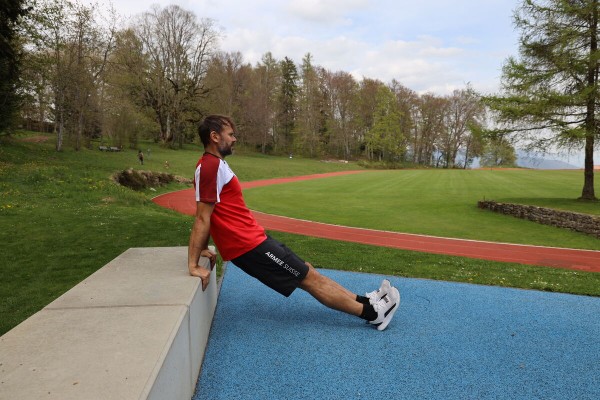
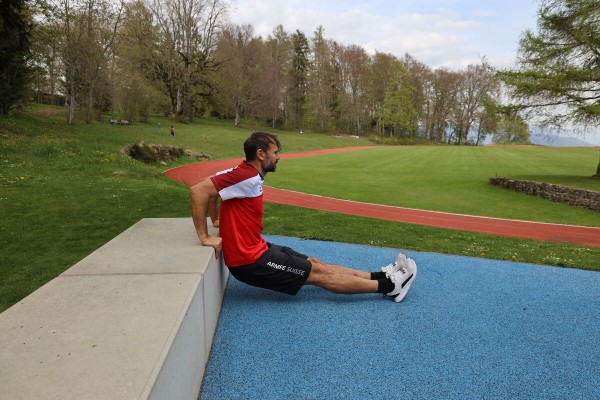
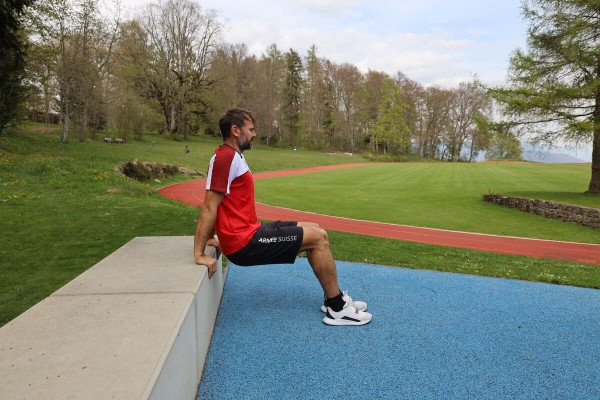
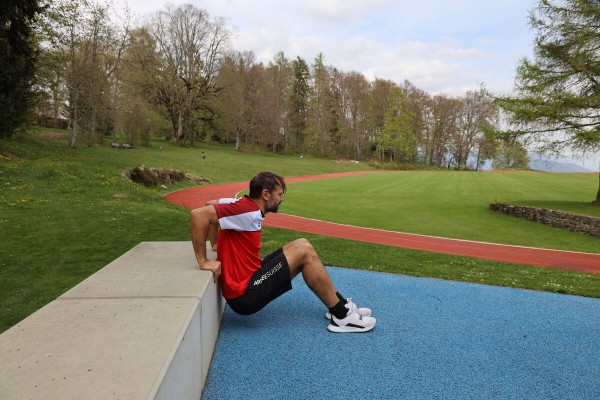
Four-foot stance backwards in front of the plyo box or a similar elevation (e.g. bench), support your upper body with your hands on the elevation (arms behind your body), hands pointing towards your body, bend and stretch your arms (raise and lower your upper body).
Attention:
Elbows point backwards, keep your shoulders fixed (press towards your hips).
Lighten:
Foot closer to the elevation (legs more bent); bend arms less.
Harden:
Foot further away from the elevation (legs stretched and resting only on the heels); additional weight (on the thighs); unstable support for the legs.
1 plyo box/staircase/bench or similar
1 weight disc/sandbag/fighting rucksack ► to make the exercise more difficult (additional weight)
1 ball/balance cushion/balance board ► to make the exercise more difficult (unstable base)
Extension and flexion of the arms in four-foot stance backwards ► tricep dip
Power
Individual work


Inverted four-foot stance (chest facing upwards, body supported on the hands and feet, fingertips pointing forwards in the direction of gaze). The legs are bent and the pelvis is slightly raised. Bend and straighten your arms to raise/lower your upper body.
Lighten:
Position your feet closer to your buttocks.
Harden:
Place your feet further away from your buttocks; add weight (on your hips).
1 weight vest/weight disc/dumbbell/sandbag ► make the exercise more difficult (additional weight)
Extension and flexion of the arms in prone position (pull-up) ► floor sliding pull up
Power
Individual work
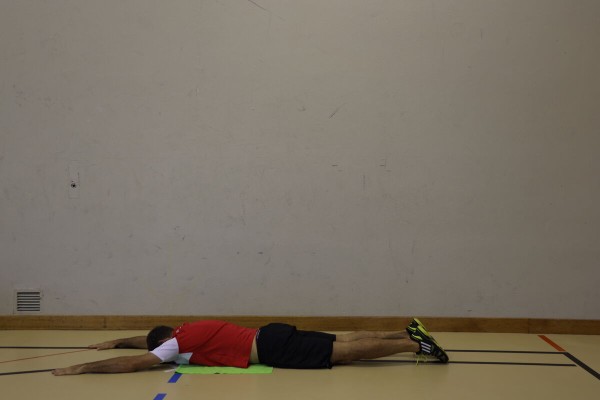

Lay on your stomach with your chest on a towel or a piece of carpet, arms flat on the floor and stretched out in front of you (palms on the floor). Bend your arms so that the upper arms are at shoulder height and point to the side and the forearms continue to point forwards (90 degree angle at the elbow joint). Then stretch your arms back out to the starting position. These movements move the body forwards and backwards along the floor; the movement simulates a pull-up on a horizontal bar.
Lighten:
Support the movement with your feet.
Harden:
Additional weight (on your back).
1 towel/carpet remnant
1 weight vest/weight disc ► to make the exercise more difficult (additional weight)
Extension and flexion of the arms in prone position (rowing pull) ► row
Power
Individual work


Prone position on the Swedish box (head protruding over the end of the box), arms stretched downwards (hanging), hold dumbbells in your hands (or elastic band stretched under the Swedish box), pull elbows upwards as far as possible (place dumbbells/elastic band next to your head, pull shoulder blades together).
Attention:
No hollow back, movement only from the shoulders (do not lift the upper body).
Lighten:
No resistance from additional weight (only bend arms); less weight/resistance (softer elastic band).
Harden:
More weight/resistance (harder elastic band).
1 swedish box
2 dumbbells or 1 elasticated rubber band
Extension and flexion of the arms in prone position (rowing pull) ► row
Power
Individual work

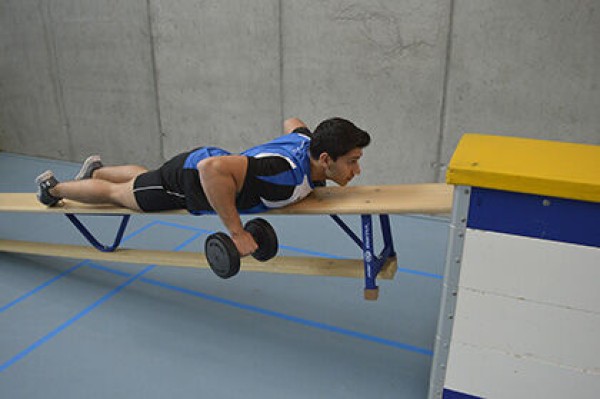
Prone position on the inclined long bench (long bench attached to the Swedish box or wall bars), arms (almost) stretched out downwards with the dumbbells in your hands, the backs of your hands pointing forwards in your line of vision (overhand grip), pull your hands/dumbbells towards your body/chest to approximately the height of the lying surface (pull your shoulder blades together).
Attention:
Do not fully extend your arms (maintain tension).
Lighten:
Less weight.
Harden:
More weight.
1 vaulting box or wall bars
1 long bench
2 dumbbells
Extension and flexion of the arms in prone position ► push up
Power
Individual work


Prone position on the exercise ball (hips resting on the ball, legs stretched out and raised off the floor as an extension of the body), hands placed on the floor supporting the upper body (wide arm position), arms bent and stretched (push-up).
Attention:
Always stabilise the head in the extension of the spine, elbows bent approx. 45° from the upper body ("A" shape with the arms), shoulders are fixed and pulled down towards the hips.
Lighten:
Just hold the position (without bending and stretching the arms); lower the upper body less (hardly bend the arms).
Harden:
Shift the ball further towards the feet.
1 exercise ball
Extension and flexion of the arms in prone position ► superman
Power
Individual work
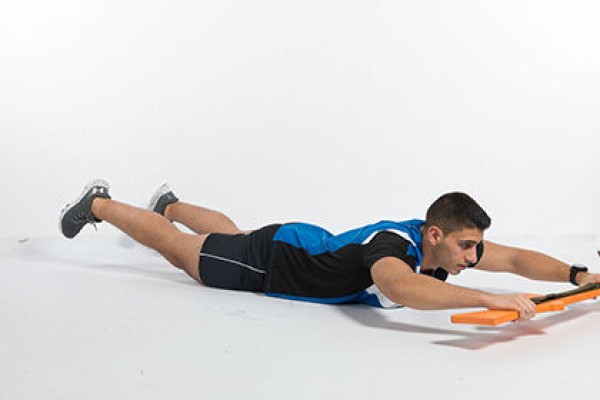
Stomach position, hold the assault rifle in both hands (one hand on the butt, the other on the hand guard), stretch your arms out in extension of your body, raise your upper body and legs slightly, bend and stretch your arms to bring the weapon to your chest/head and back to the starting position.
Attention:
Do not lower your upper body completely.
Lighten:
Hold the starting position only.
1 assault rifle (neutralised)
Extension und Flexion der Arme in hängender Position ► inverted row
Power
Individual work
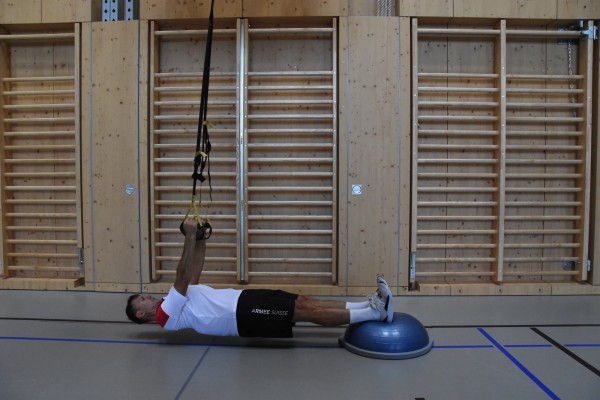
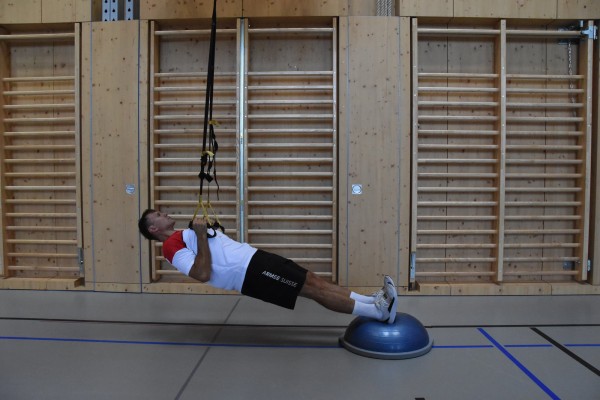
Lie on your back with your legs supported by your heels on the balance hemisphere and your hands gripping the handles of the sling trainer (lower height, hammer grip). Bend and stretch your arms to raise your upper body to a horizontal position and lower it back to the starting position.
Attention:
Keep your body tensed (no sagging); keep your head in a neutral position.
Lighten:
Legs placed on the floor.
Harden:
Heels supported on the balance board; additional weight.
Variation:
Bend arms and hold position (horizontal position).
1 sling trainer
1 balance hemisphere
1 balance board ► to make the exercise more difficult (unstable base)
1 weight vest ► to make the exercise more difficult (additional weight)
Extension and flexion of the arms in push-up position / forearm support ► stair walk push up position
Power
Partner work
Exercise both muscle groups ►Note the change of position
(= double the time required; for lesson planner see organization strength: info button execution)


One participant is in a forearm support, the other participant is in a push-up position to the side of their partner at torso height (the participants' body view corresponds to the letter "T"). The participant in the push-up position climbs onto their partner's back with their hands (one hand at a time, alternating the order, climbing stairs with their arms) and then descends back to the starting position.
Caution:
Tense the torso, do not let the pelvis sag (applies to both participants), elbows bent at an angle of approx. 45° from the upper body during the push-ups ("A" shape with the arms), shoulders are fixed and pressed down towards the hips.
Lighten:
Lower your knees (applies to both participants).
Harden:
Additional weight (on your back).
Lighten/harden:
Only hold the end position (= less strain on the upper body of the exerciser in the push-up position, but more strain on the core muscles of the exerciser in the forearm support).
Variant:
An additional push-up is performed on the partner's back.
1 weight vest/weight disc/sandbag ► make the exercise more difficult (additional weight)
Extension and flexion of the arms in the negative supine position ► decline chest press
Power
Individual work
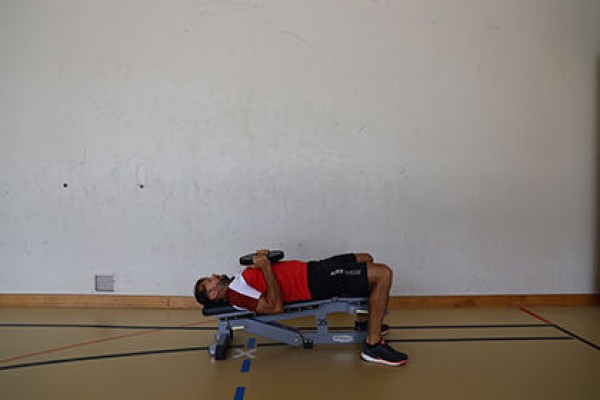



Sit on your back on the flat bench in a negative position, i.e. pointing downwards (decline) (head closer to the floor than the legs). Hold the weight disc in front of your chest with your arms bent (elbows close to your body pointing forwards), grasp the edge of the weight disc with both hands (disc pointing horizontally towards the floor), or pinch the disc between your palms for additional strain on your chest muscles (disc pointing horizontally towards the floor), push the weight upwards to bring your almost fully extended arms into the front hold position, then lower/bend your arms back to the starting position.
Attention:
Do not fully extend your arms in the holding position and do not place the weight completely on your chest when lowering.
Lighten:
Less weight.
Harden:
More weight.
Variant I:
Bench in a straight/flat position (flat bench) or in an inclined position with the seat facing upwards (incline).
Variant II:
Replace the weight disc with dumbbells. Hold the dumbbells with a neutral grip so that the palms are facing the respective side, push the weights upwards shoulder-width apart to bring the almost fully extended arms into a holding position (without bringing the weights together), then lower/bend the arms back to the starting position.
Variant III:
Replace the weight disc with dumbbells. Grasp the dumbbells with a neutral grip and press them firmly against each other, palms facing each side, push the weights upwards to bring the almost fully extended arms into a holding position (press the dumbbells firmly together throughout the exercise), then lower/bend the arms back to the starting position.
1 flat bench
1 weight disc
2 dumbbells ► variation of the exercise
Extension and flexion of the arms in the negative supine position ► decline chest press
Power
Individual work

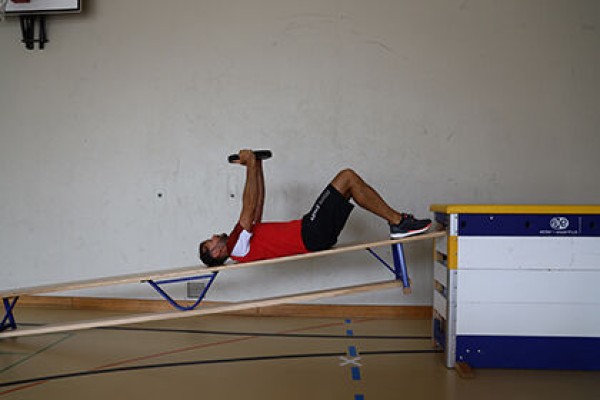
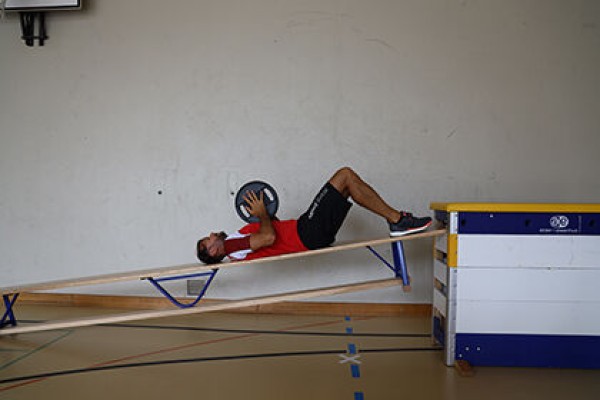

Sit on your back on the inclined long bench (long bench attached to the vaulting box or wall bars) with your head closer to the floor than your legs (legs may be attached to the box or wall bars). Hold the weight disc in front of your chest with your arms bent (elbows close to your body pointing forwards), grasp the edge of the weight disc with both hands (disc pointing horizontally towards the floor), or pinch the disc between your palms for additional strain on your chest muscles (disc pointing horizontally towards the floor), push the weight upwards to bring your almost fully extended arms into the front hold position, then lower/bend your arms back to the starting position.
Attention:
Do not fully extend your arms in the holding position and do not place the weight completely on your chest when lowering.
Lighten:
Less weight.
Harden:
More weight.
Variant I:
Replace the weight plate with dumbbells. Hold the dumbbells with a neutral grip so that the palms are facing the respective side, push the weights upwards shoulder-width apart to bring the almost fully extended arms to the holding position (without bringing the weights together), then lower/bend the arms back to the starting position.
Variant II:
Replace the weight disc with dumbbells. Hold the dumbbells with a neutral grip and press them firmly against each other, palms facing each other, push the weights upwards to bring the almost fully extended arms into the holding position (press the dumbbells firmly together during the entire exercise), then lower/bend the arms back to the starting position.
1 vaulting box or wall bars
1 long bench
1 weight disc
2 dumbbells ► variation of the exercise